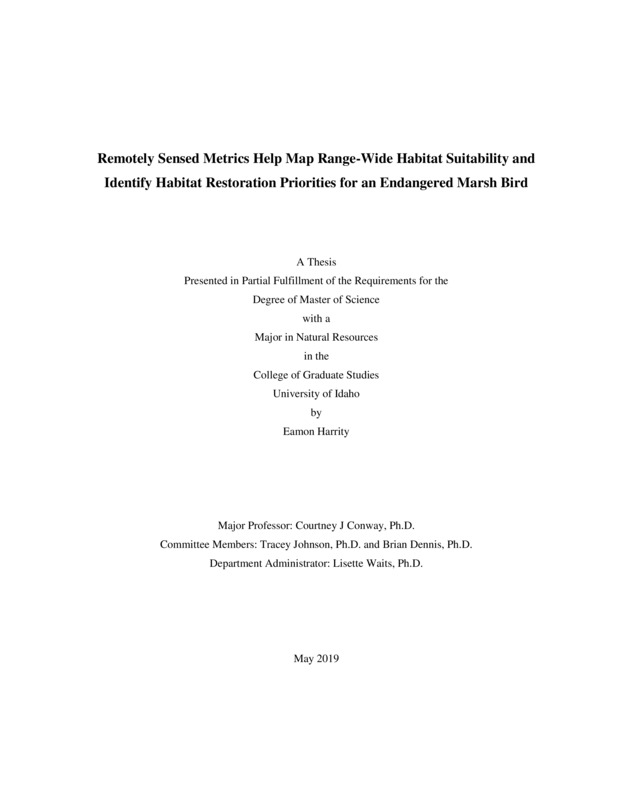Remotely Sensed Metrics Help Map Range-Wide Habitat Suitability and Identify Habitat Restoration Priorities for an Endangered Marsh Bird
Harrity, Eamon. (2019-05). Remotely Sensed Metrics Help Map Range-Wide Habitat Suitability and Identify Habitat Restoration Priorities for an Endangered Marsh Bird. Theses and Dissertations Collection, University of Idaho Library Digital Collections. https://www.lib.uidaho.edu/digital/etd/items/harrity_idaho_0089n_11597.html
- Title:
- Remotely Sensed Metrics Help Map Range-Wide Habitat Suitability and Identify Habitat Restoration Priorities for an Endangered Marsh Bird
- Author:
- Harrity, Eamon
- Date:
- 2019-05
- Keywords:
- Google Earth Engine Habitat Suitability Modeling Relative Abundance Remote Sensing Yuma Ridgway's Rail
- Program:
- Natural Resources
- Subject Category:
- Wildlife conservation; Wildlife management
- Abstract:
-
Managers and policy-makers are often confronted with the difficult task of allocating limited resources to conservation efforts and habitat management actions. Data to inform the allocation of resources can be collected in the field, but the high costs and logistical complications of field-based approaches often render large scale field data collection efforts impractical. Satellite remote sensing has become increasingly important to informing conservation decisions because it can serve as an efficient means to collect earth observations. For example, satellite-derived data have been used to track ecosystem degradation, monitor restoration efforts, map land cover, and predict biodiversity. Significant challenges still hinder the wider application of satellite remote sensing techniques in conservation planning. For instance, using satellite imagery often requires expertise in remote sensing techniques, access to expensive image processing software, and the capacity to manage large datasets. These challenges hinder the development of useful information (e.g., habitat assessments) and the dissemination of results (e.g., maps of habitat suitability) to land managers and policy-makers.
We used publicly available Landsat data and generalized linear mixed models to link satellite-derived metrics of marsh condition with the relative abundance of the federally endangered Yuma Ridgway’s rail (Rallus obsoletus yumanensis). We followed a rigorous model selection process to: 1) identify the most appropriate set of marsh condition variables that best predict rail abundance; 2) optimize the temporal scale at which we measured these predictors; 3) identify the optimal statistical distribution with which to model rail abundance; and 4) account for the spatio-temporal dynamics of a fragmented and stochastic ecosystem (freshwater emergent marshlands). Our model selection process allowed us to objectively select the most parsimonious model for inference. We applied the results of our rail abundance models to generate range-wide predictive maps of habitat suitability at a fine spatial grain (30 m). Such maps will help target management actions, both spatially and temporally, throughout the range of this endangered bird. Moreover, we developed a reliable way to detect wetland disturbances with Landsat imagery, which may help determine how frequently to re-apply management actions.
We addressed many of the challenges facing the use of satellite remote sensing by working with the web-based (and freely available) Google Earth Engine to process large datasets of Landsat imagery and generate maps of habitat suitability. These maps of habitat suitability are shareable, interactive, and easy to update and will enhance our ability to prioritize management actions for recovery of an endangered bird. We focused on the Yuma Ridgway’s rail, but our methods could be applied to other species of conservation concern.
- Description:
- masters, M.S., Natural Resources -- University of Idaho - College of Graduate Studies, 2019-05
- Major Professor:
- Conway, Courtney J
- Committee:
- Johnson, Tracey N; Dennis, Brian
- Defense Date:
- 2019-05
- Identifier:
- Harrity_idaho_0089N_11597
- Type:
- Text
- Format Original:
- Format:
- application/pdf
- Rights:
- In Copyright - Educational Use Permitted. For more information, please contact University of Idaho Library Special Collections and Archives Department at libspec@uidaho.edu.
- Standardized Rights:
- http://rightsstatements.org/vocab/InC-EDU/1.0/

